What Kind of Surround Speakers Do I Need?
As more and more of my friends consider finally adding surround sound speakers to their living rooms, I’m starting to get asked a lot of questions. And the answers aren’t all the same…nor are they simple. Depending on the type of room you have, the particular kind of surround sound speakers you may be interested in will change. I think the best way to explain this is to go through the different types of surround speakers rather than the different types of rooms. Primarily, this is because I can contain the discussion on speakers, whereas there are a near-infinite number of living space configurations.
When you understand the speaker types, you can better understand which is best for you room. So here it goes. Let us know if this is helpful, and be sure to add any questions you have in our comments section at the bottom.
Dipole and Bipole Surround Speakers
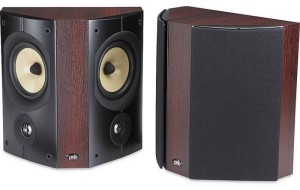 Of all the types of speakers available for use in surround sound, the dipole and bipole speaker may be the one deemed the quintessential of the genre. We have other articles that talk about the differences between bipole and dipole speakers, but suffice it to say, these speakers are designed for side wall placement. This is important because not every room will support side surrounds. A good example of an incompatible room is one that has an opening to the left or right of the primary sitting position. While dipole and bipole speakers can technically be used on back walls, their best use is for creating a diffuse sound field to the right and left of the primary listening seats. As dipole and bipole speakers also typically cost significantly more than traditional bookshelf speakers, dropping back to a bookshelf model isn’t too much of a burden or fall-back in most cases.
Of all the types of speakers available for use in surround sound, the dipole and bipole speaker may be the one deemed the quintessential of the genre. We have other articles that talk about the differences between bipole and dipole speakers, but suffice it to say, these speakers are designed for side wall placement. This is important because not every room will support side surrounds. A good example of an incompatible room is one that has an opening to the left or right of the primary sitting position. While dipole and bipole speakers can technically be used on back walls, their best use is for creating a diffuse sound field to the right and left of the primary listening seats. As dipole and bipole speakers also typically cost significantly more than traditional bookshelf speakers, dropping back to a bookshelf model isn’t too much of a burden or fall-back in most cases.
- Use on: Rooms with side walls to the side of the primary listening position
- Avoid: When the room has openings to the side of the primary listening position
Bookshelf, Two-way Speakers
 Bookshelf speakers are perfect for Surround Back speakers, positioned either 20-30 degrees off center behind the primary listening position, or centered on the back wall when using a THX system with ASA (Advanced Speaker Array) processing. Bookshelf speakers can also make for a great surround experience when you only have a rear wall for surround sound speaker placement. In some cases, facing the speakers towards each other will create a more diffuse sound, a desirable effect for theatrical-style surround sound. Bookshelf speakers are also an excellent solution if you sit nearer to the rear wall and want to place your surround speakers on stands.
Bookshelf speakers are perfect for Surround Back speakers, positioned either 20-30 degrees off center behind the primary listening position, or centered on the back wall when using a THX system with ASA (Advanced Speaker Array) processing. Bookshelf speakers can also make for a great surround experience when you only have a rear wall for surround sound speaker placement. In some cases, facing the speakers towards each other will create a more diffuse sound, a desirable effect for theatrical-style surround sound. Bookshelf speakers are also an excellent solution if you sit nearer to the rear wall and want to place your surround speakers on stands.
- Use on: Rooms where stand-mounted surrounds are ideal or where rear-wall surrounds are best
- Avoid: When your primary seating can benefit from true dipolar side surrounds
In-ceiling Speakers
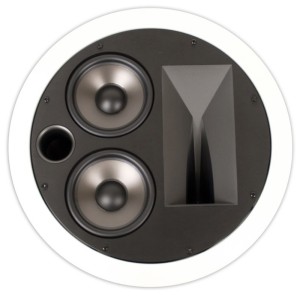 In some cases, chiefly when you have a situation where your seated position has a large opening behind it or you cannot place surrounds on your side walls, there may be a case for using in-ceiling surrounds. In-ceiling surround speakers can be placed virtually anywhere, and many models offer tuning and directionality that affords them an advantage as surround speakers. Obviously, in-ceiling speakers are going to be easier to install when you have attic access, but even if you don’t, there are secrets to running the wiring on a bottom floor of a two-story home. Crown moulding can help, and you can run the wiring in the ceiling to the nearest wall to get to the point where you can route it around the baseboard to your AV equipment.
In some cases, chiefly when you have a situation where your seated position has a large opening behind it or you cannot place surrounds on your side walls, there may be a case for using in-ceiling surrounds. In-ceiling surround speakers can be placed virtually anywhere, and many models offer tuning and directionality that affords them an advantage as surround speakers. Obviously, in-ceiling speakers are going to be easier to install when you have attic access, but even if you don’t, there are secrets to running the wiring on a bottom floor of a two-story home. Crown moulding can help, and you can run the wiring in the ceiling to the nearest wall to get to the point where you can route it around the baseboard to your AV equipment.
- Use on: Rooms where there is open space behind the main listening position or where side or stand-mounted surrounds are impractical
- Avoid: When you can use more traditional surround speakers
Hopefully this helped you get an idea of the different options and types of surround sound speakers you may want to install in your theater or listening room (or in the room of someone you know). I’ve actually installed several of each over the years, and while I typically push for more standard solutions, the in-ceiling and bookshelf speaker options are extremely handy when they are needed.
If we missed something, leave us a comment below and let us know.

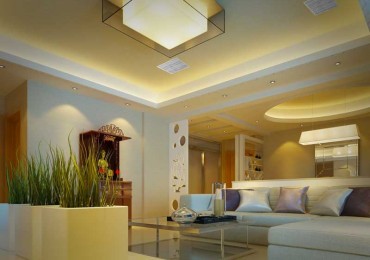
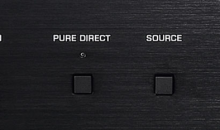
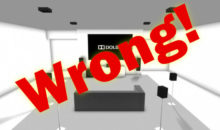



Hi Clint, looking for some suggestions and or opinion. I currently have a 7.1 set-up with 4 in-ceiling speakers for side & rear surround. I have been looking at adding 2 more speakers and upgrading to a dolby atmos 5.1.4 set-up. If I were to use the ceiling speakers for atmos what would you recommend for my surround? (bi-pole / di-pole or bookshelf) Does bi-pole or di-pole work well with what atmos is trying to accomplish? Thanks for any advise.
I want a super sound system with tv sround sound and big wattage!
My space has a lot of potential and is void of any furniture as write this. 25 ft X 20 ft open living area w/ Bamboo hardwood flooring. 18 ft cathedral ceiling. It is the main entrance w/ bump outs adjoining the Dining and Kitchen. It’s big and echo(ey) I am only going to be listening to music in this zone. I like uncluttered and simple; don’t want a bunch of cords and wires but for the right system, would consider wired. I’m looking at bluetooth towers and sub combo, I like the bluetooth option but can I do better with wired? With a rug and sofa it would deaden some sound but I’m curious about placement and where I can get the best spatiality and coverage. Thoughts?
I’m a complete idiot when it comes to the technical side of home theatre equipment. Can you recommend a good out of the box surround system with a price range of 1000 to 1500? Also, could you recommend a good easy to operate receiver? I only intend to set up my Sony Bravia EF9 TV and a Blue Ray DVD player.